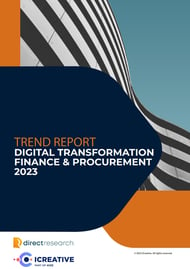3 min read
Slow Adoption of E-Invoicing: Traditional Paper Invoices Remain Popular
Editorial ICreative
Jul 27, 2023 10:04:12 AM

The Netherlands was the third "most advanced digital economy" in Europe last year, according to the Dutch Central Bureau of Statistics (CBS). However, this extensive digitization has resulted in a striking contradiction within the Accounts Payable departments of Dutch companies. The Trend Report on Digital Transformation in Corporate Finance and Procurement reveals that whilst e-invoicing is slowly gaining ground, there is still a persistent preference to traditional paper invoices. Surprisingly, one in five corporate companies still receives regular invoices by mail.
More than a third of Dutch corporates have currently embraced e-invoicing, concludes independent research agency DirectResearch after surveying more than 200 financial and procurement experts from companies with more than 500 employees. These corporates regularly receive e-invoices either directly into their invoice processing systems or as XML documents via email.
However, 15 percent of large companies still claim to never receive e-invoices.
PDF remains most popular invoice format
The majority of invoices still arrive at Accounts Payable through email in the form of a PDF document. More than half of the corporate companies in the Netherlands always or often receive invoices this way. Additionally, 22 percent of financial professionals occasionally retrieve invoices from an online portal, while 17 percent primarily use EDI (Electronic Data Interchange).
Perhaps most surprisingly, 21 percent of financial professionals state that they often or always receive paper invoices from their suppliers. Only a mere 11 percent of corporate companies have completely bid farewell to paper invoices.
Medium-sized companies receive e-invoices more frequently
DirectResearch conducted a similar survey among financials and procurement officers from medium-sized businesses. When we compare the figures from corporates to those from medium-sizes business, a discrepancy emerges. On one hand, medium-sized companies seem better prepared for the future than corporations, as they use e-invoicing more often. On the other hand, paper invoices are still more prevalent in medium-sized companies.
More than half of medium-sized companies state that they frequently or always receive e-invoices directly into their invoice processing systems, and one-third regularly receives XML documents via email. However, at the same time, a third of medium-sized businesses still frequently or always receive paper invoices. A meager 6 percent of the medium-sized companies have completely phased out paper invoices.

|
| ALSO READ: |
Government sets the precedent
In conclusion, while e-invoicing is gaining traction in Dutch companies, it is still not a common practice. As of the end of 2022, only 10 percent of all invoices in the Netherlands were sent via e-invoicing, states Jorden van der Wateren, Coordinator at the Dutch Peppol Authority, in an episode of the podcast DigiFinance. He asserts that the organic adoption of e-invoicing is "far too slow."
This is in stark contrast to the Dutch government, where e-invoicing already is the standard. They now exclusively receive e-invoices from their suppliers, no longer accepting PDFs, paper bills, or other forms of invoicing. However, this rigorous example set by the government is only gradually permeating the Dutch business to business field.
Automated invoice approval via matching
Besides the method of receiving invoices, it is also interesting to explore how received invoices are approved. This aspect of the purchase-to-pay process appears to be more automated, based on the results from the independent research conducted by DirectResearch.
At half of the corporate companies, invoices are frequently or always approved automatically through matching. Additionally, 53 percent of financial professionals state that approval often or always occurs manually based on a workflow system. Manual approval via paper or email is relatively uncommon.
Looking at the complete invoice processing process, it becomes evident that there is still much room for improvement through automation. Only 1 percent of Accounts Payable departments in corporates receive and process all incoming invoices fully automatically, without any manual intervention. 41 percent of financial professionals indicate that more than half of the incoming invoices are processed entirely automatically. However, at one-fifth of Dutch corporate companies, there is still no fully automated invoice processing system.
Full Trend Report available for free
Would you like to learn more about how corporations have structured their purchase-to-pay process and the implications for Procurement and Finance? You can download the complete trend report for free.
In the report, you'll find insights on:
- The extent to which indirect spend poses challenges for Finance and Procurement.
- How purchase orders and invoices are generated within Dutch corporations.
- The trends and developments influencing Procurement and Accounts Payable.








